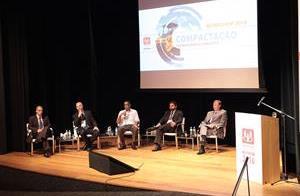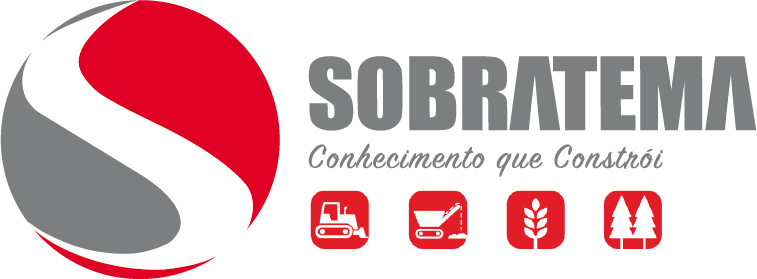Publicado em 27 de abril de 2016
Panel of Sobratema Workshop 2016 highlights the importance of appropriate equipment selection to ensure efficient soil compaction
Speakers also highlighted technologies to increase compaction productivity. The event also included a panel about asphalt compaction

The first presentation in the panel about Technologies for Soil Compaction was performed by Marcelo Prado Ritter, Sales and Marketing Coordinator of the Ammann Group, who brought information about the reasons why the soil is compacted: to increase its load capacity, stability and homogeneity; to remove water and porosity; to reduce its permeability and to increase its resistance to deformation. “Summing up, to improve the properties of the soil”, emphasized him.
Ritter also detailed the three methods of compaction: compression or kneading, compaction by the material weight or by other natural energy (static), compaction by the effect of external-supplied energy. He also detailed the application of compactors according with the soil: smooth drum roller (indicated for rocks, gravel and sand), tire compactors (indicated for gravel and sand) and padfoot drum rollers (indicated for gravel, sand, silt and clay).
In addition, Ritter talked about equipment for light compaction, such as attached plate compactors. “This equipment may be used in excavators which—due to their reach—may operate in places of difficult access such as deep, narrow ditches and particularly steep slopes”, said him. He also talked about percussion compactors, vibrating plates and trenching equipment.
The second presentation was carried out by Carlos Eduardo dos Santos, Product Manager of Atlas Copco, who showed the basic principles of compaction and paving and informed what define the production of a compactor to ensure a better productivity.
There are four variables to be considered: type of soil, layer thickness, compaction degree and length of the section, in addition to compactor width and speed of the roller or runtime. The result is the compacted cubic meter.
To give an example, Santos brought the case of a self-propelled compactor that reduced the number of passes from 12 to 8, got a productivity increase of 50 percent and was cost-effective. To get these results the variables related to compaction effects were also considered: weight of the front module, centrifugal force, shape and layout of the pads, amplitude and frequency. “There is no formula to ensure a perfect combination among these four variables. Each manufacturer carries out its tests related to amplitude and frequency to get the best combination between them”, explained him.
According to Santos, to ensure higher productivity it is necessary to pay attention to the details. “If I am working in a soil composed by clay, I have to select properly the equipment, since this selection will influence the productivity”, pointed him. In addition, he pointed out in his presentation three technologic tools that help in this point, including telemetry systems.
Rodrigo Pereira, Business and Product Manager of Bomag Marini was the third talker of the first panel of the Sobratema Workshop. In his presentation, he developed an analysis about compactor technologies and their applications, such as the efficient compaction in tamping rollers, which have as their main features the kneading effect and the complete coverage of the surface, being ideal for large areas and for dam construction.
The talker also made available information, concepts and purposes of solid waste compaction, which include use of space and reduction of landslides, fire risks, pests and garbage dispersion in the environment due to wind action. “The main influences in waste compaction are: operating weight, design of wheels, type and condition of the residues and operating techniques”, informed him. There are also other parameters to be considered, such as the type of sanitary landfill, weather conditions and application techniques.
In this sense, Pereira points out that the waste compactor is the ideal equipment to be used in sanitary landfills because it ensures a better result of compaction if compared to a crawler tractor. “The specific soil compression of the tractor is too low, approximately 7 N/sq.cm., therefore the compaction effect is also low. The compactor brings a compression of approximately 240 N/sq.cm., what also ensures good results also in residue crushing and in the kneading effect”, explained him. He points also that in some applications such as dumping operations the use of compactors is not recommended because the density of residue is poor.
To close the first round of lectures, Luiz Barreto, Latin America Business Development Manager of XCMG Brasil warned about the importance of an appropriate compaction obtained through the proper selection of the equipment—according to design specifications—to improve the quality of Brazilian roads and to reduce the number of accidents due to soil compaction problems. “Market data show that approximately 16 percent of road accidents are caused by poor compaction”, added him.
Barreto also detailed the main features of compactors and introduced concepts of telemetry systems which bring benefits such as identification of failures and study of solutions, warnings for revisions, management of engine operation and history of work, as well as communication between user and operator.
He also brought information about intelligent systems of support to the user, which allow the presentation of a compaction roadmap with places already concluded and work needs, and the issue of a compaction performance report with information about number of passes, operating speed and working hours.
The Sobratema Workshop 2016 also had a second panel about Technologies for Asphalt Compaction, developed by experts from Caterpillar, Ciber Equipamentos Rodoviários (Wirtgen Group) and Volvo Construction Equipment. Works were opened by Afonso Mamede, President of Sobratema, and the Moderator was Claudio Schmidt, Technical Director of Sobratema.
The Sobratema Workshop 2016 was supported by Atlas Copco, Ammann Group, Sotreq/Caterpillar, Volvo and XCMG.
More information: http://www.sobratemaworkshop.com.br

Av. Francisco Matarazzo, 404 Cj. 701/703 Água Branca - CEP 05001-000 São Paulo/SP
Telefone (11) 3662-4159
© Sobratema. A reprodução do conteúdo total ou parcial é autorizada, desde que citada a fonte. Política de privacidade


